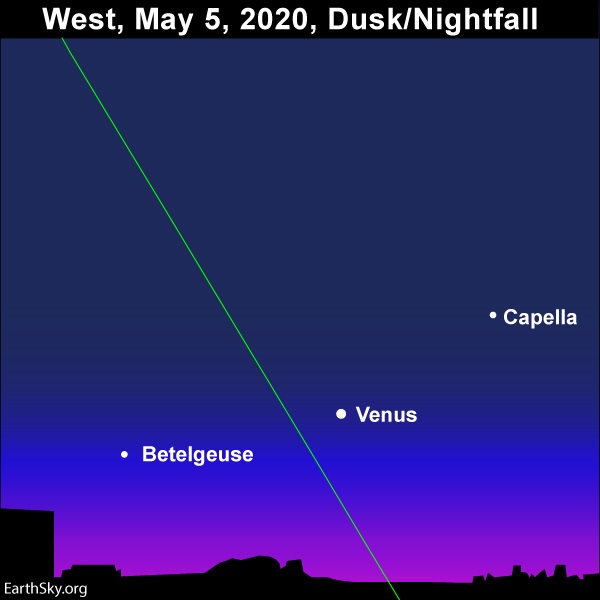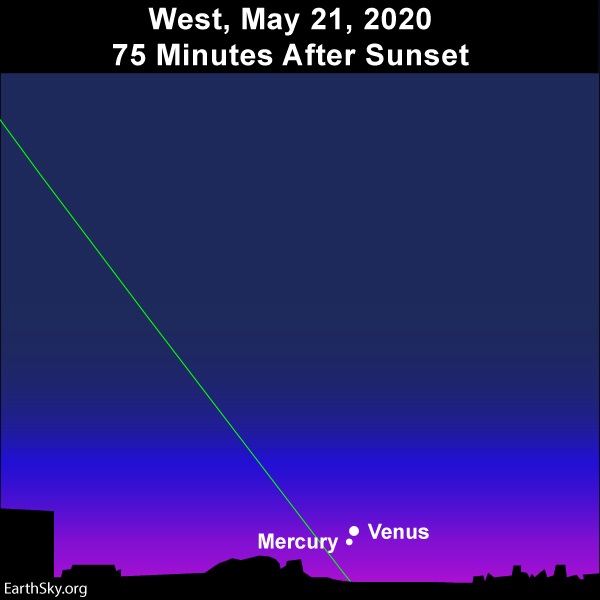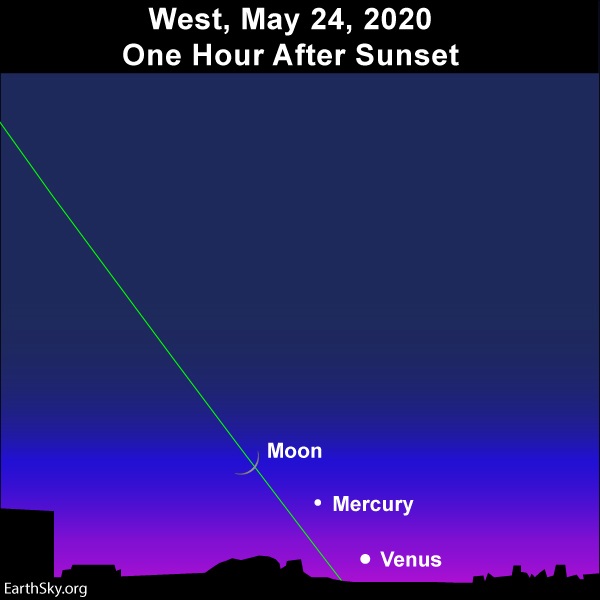
May will be the planet Venus’ last full month in the western twilight sky for the year 2020. On June 3, Venus will swing between the Earth and sun in its orbit, reaching the point called inferior conjunction by astronomers. Afterwards it’ll transition over to the eastern sky before sunup. But what an exciting month for Venus this will be! We’ll all be able to watch it sink closer to the western horizon day by day, finally disappearing in the sunset glare.
Those with telescopes will see that – as it gets closer to the sunset, preparing to go between us and the sun – more and more of its day side will be turned away from our direction in space: we’ll see Venus as a waning crescent. What’s more, the sun’s other inner planet – Mercury – will join the scene in the west after sunset beginning around mid-May. All in all, a fascinating month to watch the western sky after sunset!
Given clear skies, you can’t miss seeing Venus in your western sky after sunset. After all, dazzling Venus ranks as the third-brightest celestial body to light up the heavens, after the sun and moon. Some people can actually see Venus in a daytime sky, but we mere mortals can expect to see this bright beauty some 15 to 30 minutes after sundown.
Although Venus plunges closer and closer to the sunset each day, this world will be rather easy to view for the next few weeks. Venus stays out longer after dark at more northerly latitudes, however. At present – May 5, 2020 – Venus stays out for over 3 hours after sunset at mid-northern latitudes, 2 1/2 hours after the sun at the equator, and 1 3/4 hours after sunset at temperate latitudes in the Southern Hemisphere.
Have a telescope? This is by far the most exciting time to view Venus through the telescope. That’s because Venus in its faster orbit around the sun is rapidly catching up with our planet Earth. Therefore, Venus’ disk size is increasing while its phase is waning (shrinking). On May 5, 2020, Venus is 21% illuminated in sunshine. A week from now – May 12, 2020 – Venus will be 14% illuminated; and two weeks from now – May 19, 2020 – Venus will be 8% illuminated. Three weeks later – May 26, 2020 – Venus will be 3% illuminated. All the while, the disk size will have increased by 80%.
Keep in mind that you get a crisper view of Venus’ phase in a twilight or daytime sky than after dark. That’s because Venus’ glare is so overwhelming at nighttime.
When Galileo (1564-1642) first saw the phases of Venus through the telescope, he came to the realization that Venus must orbit the sun instead of orbiting Earth. This observation countered the widely-held notion at the time that Venus orbits Earth.
By the way, the planet Mercury entered the evening sky on May 4, 2020. However, the innermost planet probably won’t climb high enough from the sunset glare to become visible for another week or two. Fortunately, we can use Venus to help us locate Mercury in May 2020. Throughout the month, Venus will be falling toward the sunset while Mercury will be climbing away. On or near May 21, 2020, watch for these two worlds to be within one degree of one another on the sky’s dome. If you can see Venus with the eye alone, then aim binoculars at Venus to see Mercury sharing a single binocular field with Venus.

Depending on where you live worldwide, the planets Mercury and Venus will couple up most closely on the sky’s dome on May 21 or May 22, 2020. If you can see Venus, but not Mercury, aim binoculars at Venus to see Mercury and Venus taking stage in a single binocular field.
Then, only a few to several days after the Venus/Mercury conjunction, watch for the slender waxing lunar crescent to join up with Mercury and Venus at dusk. Think photo opportunity! Thereafter, Venus will continue to fall downward while Mercury will soar upward. Mercury will reach its greatest eastern elongation (greatest angular distance) from the setting sun on June 4, 2020.

Have a telescope? You’ll see the phases of the moon and Venus nearly match on or around May 24, 2020.
Bottom line: Before Venus transits to the morning sky, it will be fun to watch this upcoming month, with or without a telescope. Find an unobstructed horizon in the direction of sunset, and you might be able to view Venus in the western evening dusk until the month’s end.
Source:
https://earthsky.org/tonight/venus-final-month-in-the-evening-sky